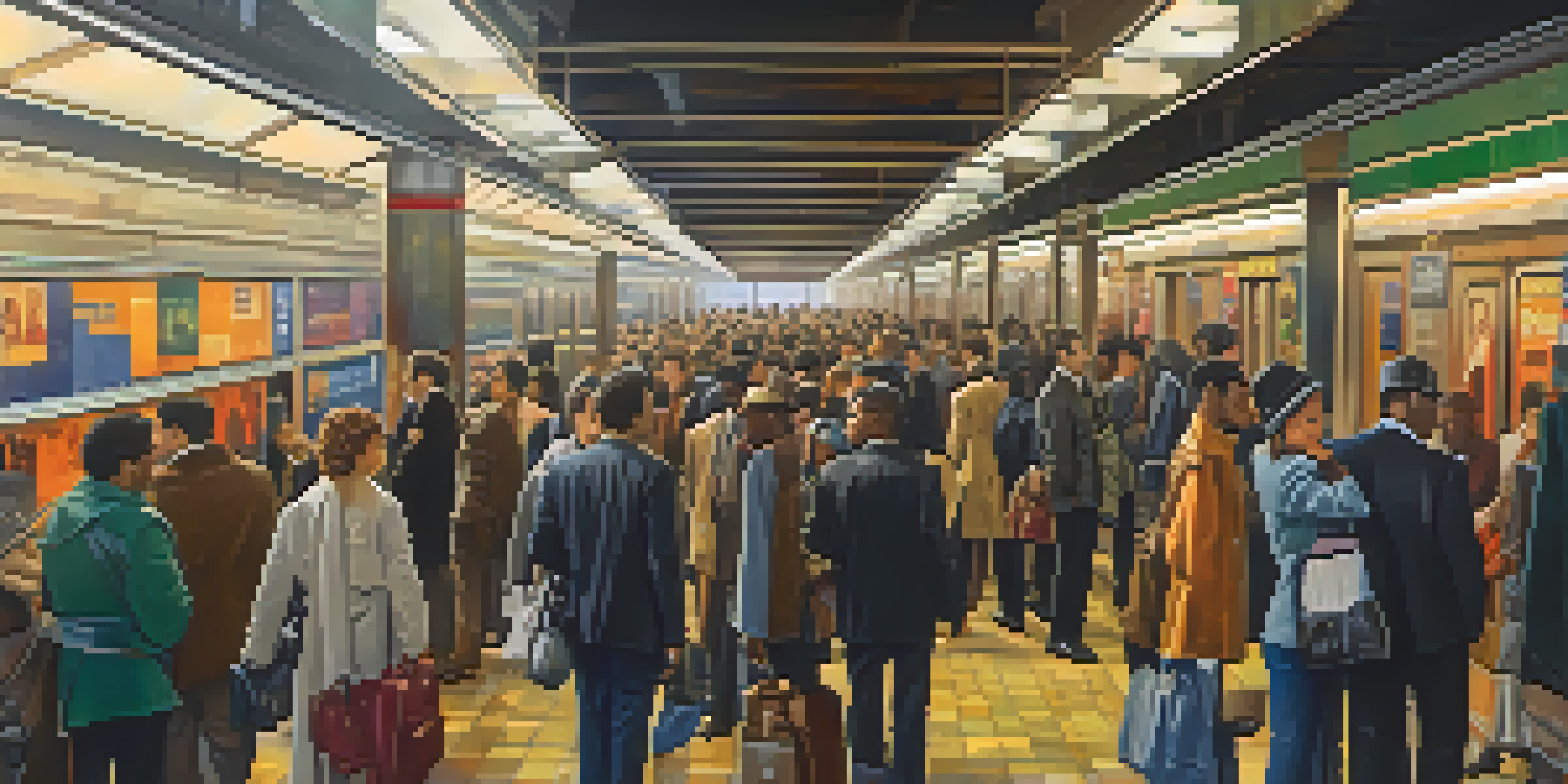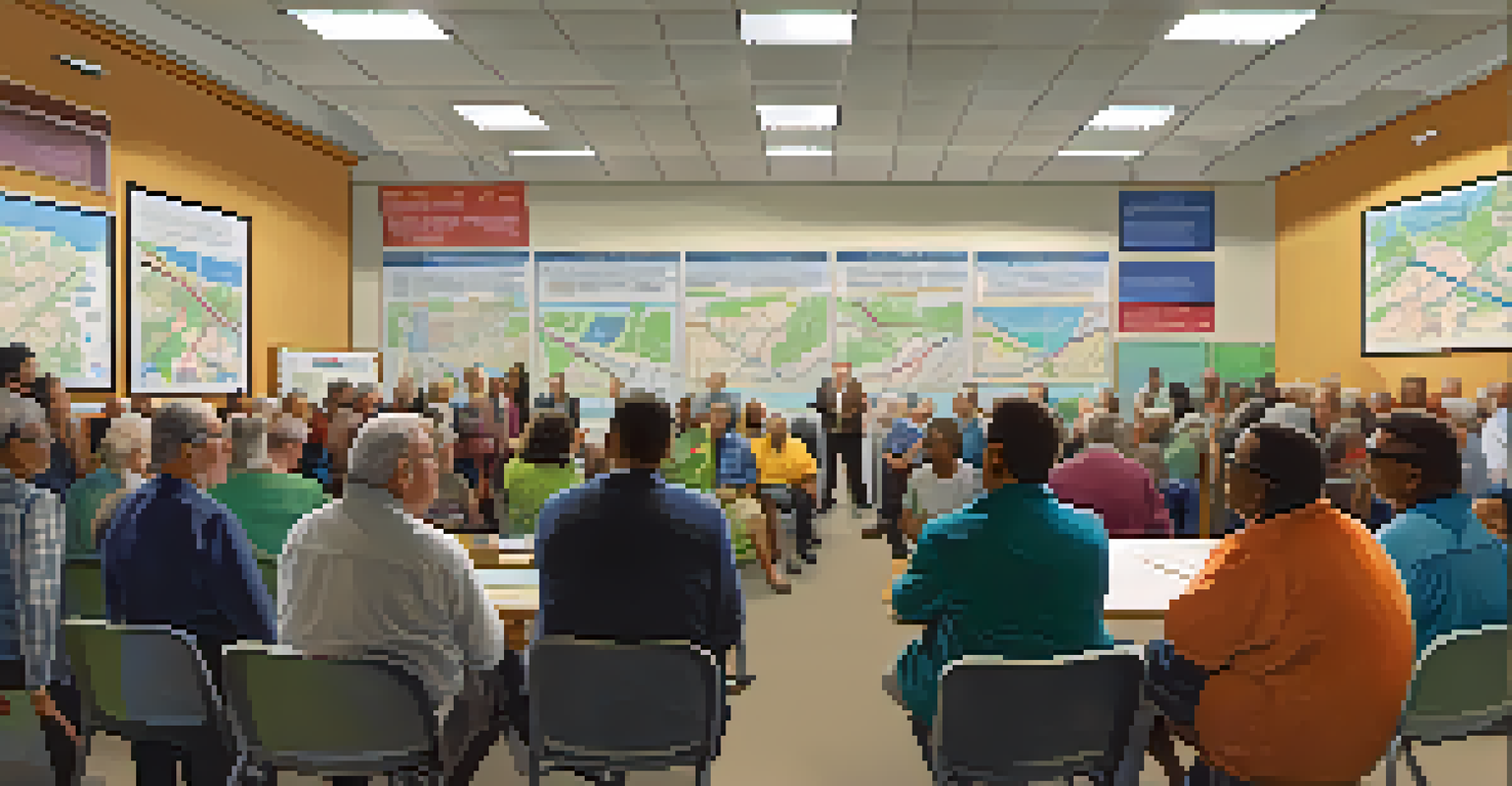Transportation Access and Economic Inequality in NYC

The Role of Transportation in Urban Economic Mobility
Transportation in New York City is more than just getting from point A to point B; it plays a crucial role in economic mobility. For many residents, access to reliable transit options can open doors to job opportunities, education, and essential services. Conversely, those living in transit deserts—areas with limited public transportation—often find themselves at a disadvantage, facing longer commutes and higher costs. This disparity can create a cycle of poverty that is hard to break.
Transportation is the lifeblood of our cities, connecting people to opportunities and services.
Consider a single mother living in the Bronx who relies on public transit to reach her job in Manhattan. If her local subway line is frequently delayed or underfunded, her ability to get to work on time is compromised. The stress of unreliable transportation can lead not only to job loss but also to missed opportunities for advancement. In contrast, those living in transit-rich neighborhoods may have easier access to multiple job prospects, making it easier for them to climb the economic ladder.
Ultimately, the transportation system serves as a lifeline for many New Yorkers, but its uneven distribution can perpetuate economic inequality. By investing in public transit improvements in underserved areas, the city could help bridge this gap, fostering a fairer economic landscape for all its residents.
The Impact of Transit Deserts on Low-Income Communities
Transit deserts are geographic areas where public transportation options are scarce or non-existent. In New York City, these areas often align with low-income neighborhoods, creating significant barriers to mobility. For residents in these communities, the lack of accessible transit can result in increased reliance on costly alternatives such as taxis or rideshares, further straining their limited budgets. This reality can trap families in a cycle of economic hardship.

For example, a family living in East New York may have to travel several miles to find a bus or subway line that connects them to jobs or schools. The time and money spent on transportation can take away from essential expenses like food and housing. Moreover, these transit challenges can contribute to social isolation, making it difficult for residents to participate in community events or access vital services like healthcare.
Transportation Affects Economic Mobility
Access to reliable transit options is crucial for job opportunities and educational access, particularly for low-income residents.
Addressing the issue of transit deserts is essential for fostering economic equity. Solutions could include expanding bus routes, increasing the frequency of service, or developing new transit lines. By ensuring that all neighborhoods have access to reliable public transportation, the city can help create a more inclusive economy.
The Financial Burden of Transportation Costs
Transportation costs can significantly impact a family's budget, particularly for those living in economically disadvantaged areas. In NYC, the cost of commuting, whether by subway, bus, or taxi, can take up a substantial portion of a low-income household's income. This financial burden forces families to make tough choices, often sacrificing essentials like healthcare or education to cover transportation expenses. As a result, the cycle of poverty can become increasingly difficult to escape.
Access to transportation is access to opportunity; it is a building block of economic prosperity.
For instance, a family that spends $200 a month on transit fares may find themselves unable to afford after-school programs for their children or necessary medical visits. The trade-offs can lead to long-term consequences, such as reduced educational attainment or deteriorating health. Essentially, high transportation costs can hinder overall economic stability and growth within these communities.
To alleviate this strain, policymakers could explore options like subsidized transit passes for low-income residents or the expansion of free transit initiatives. By reducing transportation costs, the city can help enhance the economic prospects of its most vulnerable populations, creating a more equitable urban environment.
Gentrification and Its Effects on Transportation Access
Gentrification is a complex issue that often reshapes urban landscapes, impacting transportation access in significant ways. As neighborhoods become more desirable, the influx of higher-income residents can lead to improved public transit services, but this often comes at a cost to long-standing residents. While new developments may include upgraded transit options, the rising rents and property taxes can push original inhabitants out of their homes, exacerbating economic inequality.
Take, for example, the transformation of areas like Williamsburg in Brooklyn. Once an affordable neighborhood, it has seen a surge in property values and investment, leading to enhanced transportation options. However, many long-time residents have been displaced, losing both their homes and their access to the community support networks they once relied on. This creates a paradox where improved transit options benefit newcomers while alienating those who have lived there for decades.
Transit Deserts Trap Low-Income Families
Areas with limited public transportation options create significant barriers, forcing families to spend more on transportation and widening economic disparities.
Balancing development and accessibility is essential for maintaining the character of neighborhoods while ensuring that all residents benefit from economic growth. Engaging with local communities during the planning process can help create solutions that prioritize equitable access to transportation and housing.
Public Policy Solutions for Transportation Equity
Addressing transportation access and economic inequality in NYC requires thoughtful public policy solutions. Policymakers must prioritize investments in public transit that benefit underserved communities, ensuring that every resident has access to reliable and affordable transportation. This could involve increasing funding for bus services in low-income areas, enhancing subway accessibility, or creating partnerships with rideshare companies to provide subsidized rides for those in need.
Furthermore, community engagement is vital when developing transportation policies. Involving local residents in the planning process can help identify specific needs and challenges that may not be apparent to city planners. By fostering open dialogue, the city can create tailored solutions that truly address the unique circumstances of different neighborhoods.
Ultimately, a commitment to equity in transportation policy can help break down the barriers that perpetuate economic inequality. By ensuring that every New Yorker has access to efficient and affordable transit options, the city can empower its residents to thrive and contribute to a more robust economy.
The Connection Between Transportation and Job Opportunities
Transportation access is directly linked to job opportunities, and in a city as vast as New York, this connection is even more pronounced. Many low-income residents rely on public transit to reach their jobs, and any disruptions or inefficiencies can have serious consequences for their employment prospects. A lack of reliable transportation can limit job searches to nearby areas, reducing the chances of finding better-paying positions or career advancement.
Consider a recent college graduate living in Harlem who is trying to find a job in the tech industry. If the transit options to reach tech hubs in Manhattan are limited or unreliable, she may miss out on interviews and networking opportunities. This can lead to frustration and a sense of hopelessness, further entrenching economic disparities. In contrast, those with better transportation options can explore a wider array of job opportunities, leading to greater economic stability.
Community Initiatives Enhance Access
Grassroots efforts can effectively advocate for better transit solutions, empowering residents and fostering collaboration with local governments.
To enhance job access, the city could invest in transit infrastructure that connects underserved communities to burgeoning job markets. By ensuring that residents can easily travel to and from work, the city can help reduce unemployment and improve the overall economic well-being of its inhabitants.
Community Initiatives to Improve Transportation Access
In addition to government action, grassroots initiatives can play a pivotal role in improving transportation access in economically disadvantaged areas. Community organizations often understand the unique challenges faced by their neighborhoods and can advocate for better transit options. These groups may organize campaigns to raise awareness of transportation issues or work directly with local government to propose solutions that meet the needs of residents.
For example, a community group in the South Bronx might initiate a campaign to increase bus routes or enhance accessibility for individuals with disabilities. By rallying community support, they can bring attention to their cause and influence local policy decisions. Additionally, these initiatives can foster a sense of empowerment among residents, encouraging them to take an active role in shaping their neighborhoods.

Ultimately, collaboration between community organizations and local government can create a more equitable transportation system. By working together, they can develop solutions that address the specific needs of underserved populations, ensuring that all New Yorkers have access to the resources they need to thrive.